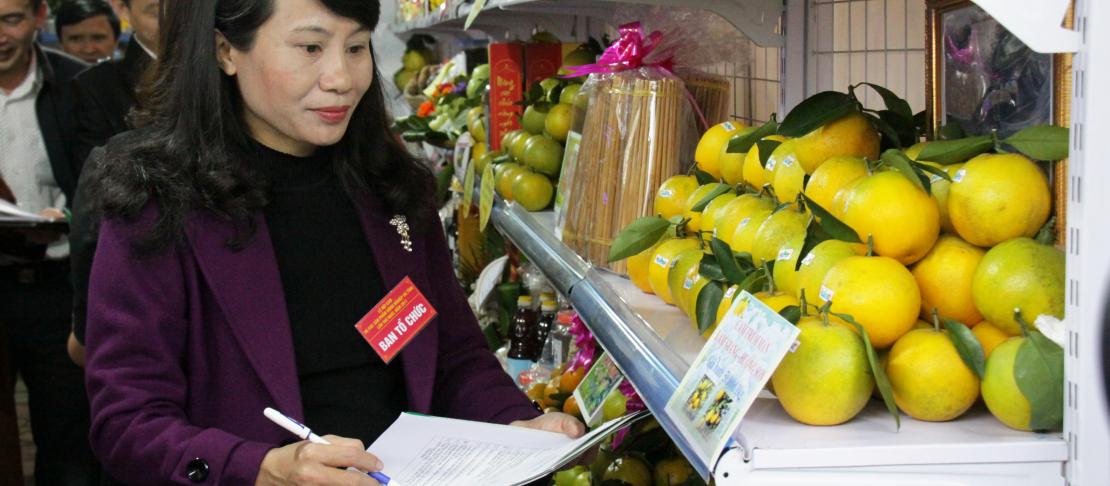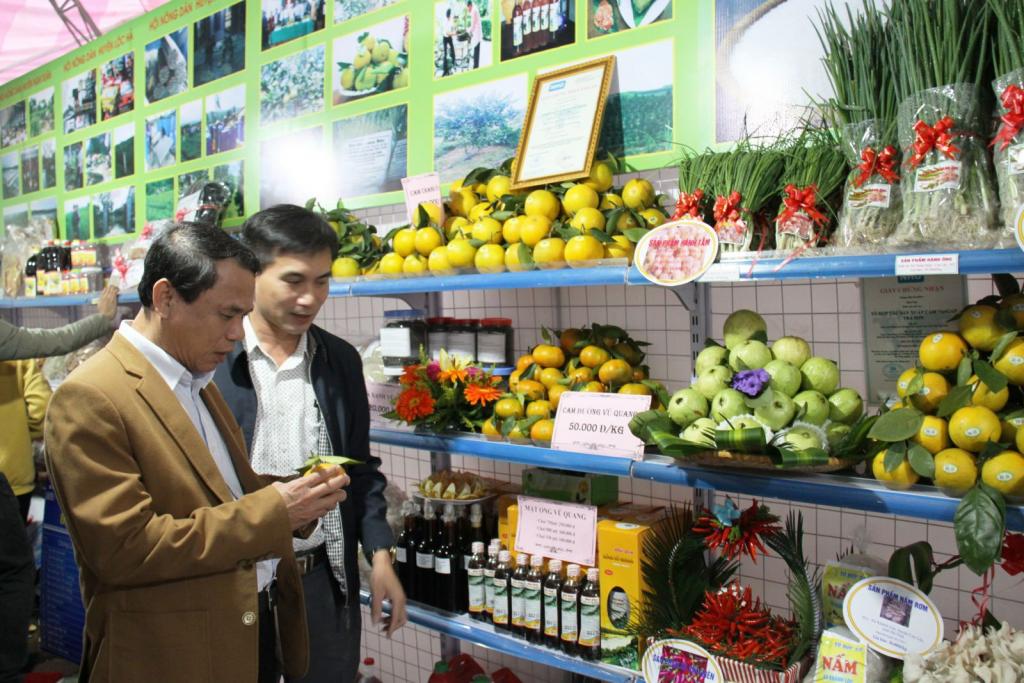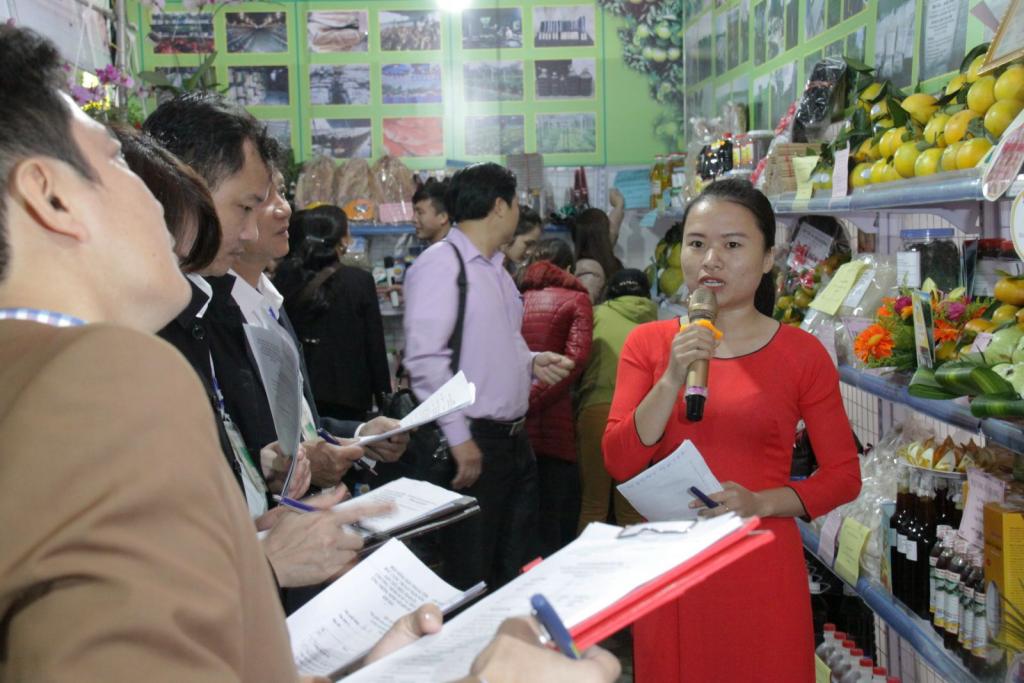Not your ordinary agri-fair: Showcasing climate-smart agriculture products and practices in Vietnam

Farmers of My Loi Climate-Smart Village showcased their climate-smart agriculture practices and products, not only to their fellow farmers, but also to the whole of Ha Tinh province in Vietnam.
Organised by the World Agroforestry Centre (ICRAF) and the One Commune, One Product programme, with support from the CGIAR Research Program on Climate Change, Agriculture and Food Security, the climate-smart agriculture (CSA) event is part of the larger Orange and Agricultural Products Festival organised by Ha Tinh Provincial People’s Committee. From 2 to 4 December 2017, the festival showcased orange, pomelo, and other agricultural products through trade fair and exhibit, competitions, seminars, and performances attracting more than 4,000 visitors.
Held on the first day of the festival, the CSA event aimed to raise awareness about climate change and its impacts, as well as the importance of adoption of CSA practices; share demonstrations and experiences on the implementation of CSA practices and products, in order to inspire wider uptake of CSA; display famous local agricultural products from different places in Ha Tinh province; provide opportunities for linking consumers and sellers; and discuss with participants how to scale up and out CSA practices in Ha Tinh province.
Fourteen mini-booths displayed a variety of CSA practices and products including seedlings, annual crops, agroforestry, forestry, medicinal plants, bonsai, aquaculture, livestock, and even agricultural tools. The most dominant and best-selling products were orange, local tangerine (Tat), Phuc Trach Pomelo, vegetables, mushroom, dried sea food, molasses, fermented pork skin, peanut, beans, and sesame. Some districts followed Vietnamese Good Agricultural Practices standard (VietGAP), designed packaging and label for their products, and established cooperatives to facilitate production and marketing.

“There are so many interesting things to see here. I bought some fruit tree seedlings (Jackfruit and Dracontomelon duperreanum) and micro-organic fertilizer and bio-fermented subtance. I also get some contacts of seedlings and micro-organic fertilizer distributors. The most interesting thing is that we, farmers from My Loi village, are invited to visit fruit tree farms in Huong Son district,” Duong Xuan Hung a farmer from My Loi village shared.
Aside from being a learning and sharing platform, the booths displays also served as entries for the best booth competition. This is to encourage the quality of the products to be displayed. With the criteria such as improving livelihood, adapting to climate variability, and mitigating GHG emission or providing environmental services, Huong Khe district won as the best booth. They showcased CSA products such as Tan Huong tea, forest honey, Areca chopsticks, and Khe May orange.
Ha Tinh’s Farmers’ Union also took the opportunity to discuss how to integrate CSA on their communication and work plans, as well as how to establish more CSA models in Ha Tinh province. According to Tran Dinh Gia, the President of the Farmers’ Union, “There are already existing and new CSA practices and technologies that have been implemented in Ha Tinh province. We are now cooperating with different partners and donors to promote the implementation and adoption of CSA approach in agricultural production, and in order for CSA to be part of our provincial plans.”

Some districts asked for support on the application of CSA on their farms or improvement of already existing CSA practices such as production of orange using net to avoid frost and pests and diseases infection during fruiting period; implementation of water-use efficient technology; and establishment of cooperative or farmer groups with market linkage consideration.
Photovoice posters, 3D model posters, and manuals were also displayed during the event to provide participants with more information on CSA. These facilitated discussions among participants about the critical problems that can be solve with CSA, and how landscapes can be designed with agroforestry models to reduce soil degradation. Seedlings were also given to the 14 participating exhibitors which they will plant using some appropriate agroforestry models in their respective districts.
Read more:
- CCAFS blog: Models for a better future: Climate-smart agriculture is spreading
- CCAFS blog: A good shot for scaling up climate-smart agriculture: Photovoice in My Loi
- CCAFS blog: Developing climate-smart farmers using knowledge-sharing and on-site learning approaches
Eisen Bernardo is the Senior Communication Specialist of CCAFS Southeast Asia.



